Saturday, 11 June 2011: The market and Brou
Written 20 June 2011
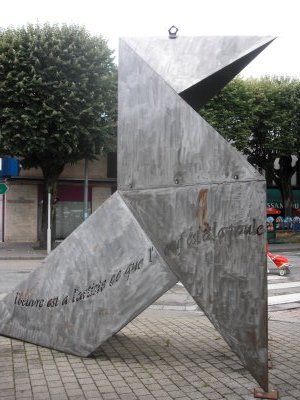
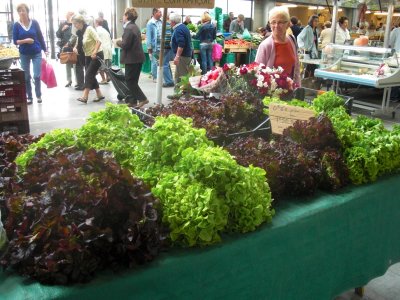 Definitely another of those shutter-happy days (and remember, of course, that every single day I took at least 20 photos for every one I have room for here). The ladies at the Office de Tourisme had mentioned that Saturday was market day, just around the corner from our hotel, so I left David a note, scarfed my breakfast, and headed out.
Definitely another of those shutter-happy days (and remember, of course, that every single day I took at least 20 photos for every one I have room for here). The ladies at the Office de Tourisme had mentioned that Saturday was market day, just around the corner from our hotel, so I left David a note, scarfed my breakfast, and headed out.
This metal object, perhaps 10 feet high, just outside the covered market, is a stylized chicken—you see a logo that shape all over products from this region—and its inscription reads "The work is to the artist as the egg is to the hen."
Apparently the "big" market day is Wednesday. This market was limited to food, plants, and some cookware—no clothing, shoes, vacuum cleaners, mattresses, etc. It filled the whole covered market—a big barn of a building—and spilled out over an acre or two outdoors, into what is ordinarily the "fairgrounds" or, when not otherwise in use, a parking lot.
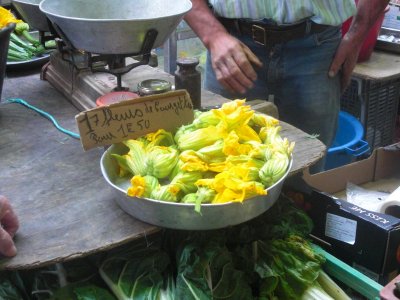
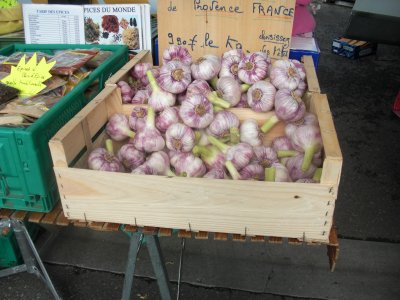 These squash blossoms, for stuffing and either poaching or frying, are the less expensive male ones—all you get is the blossom. Below them are large leaves of white Swiss chard. In the background, behind the scale, you can just see a dish of the female flowers, with their tiny zucchinis attached.
These squash blossoms, for stuffing and either poaching or frying, are the less expensive male ones—all you get is the blossom. Below them are large leaves of white Swiss chard. In the background, behind the scale, you can just see a dish of the female flowers, with their tiny zucchinis attached.
At the right is garlic. Look how fresh and green the stems are—the garlic will be very fresh and juicy.

 Here are parts of a cheese display; each photo covers perhaps 1/4 of the assortment on offer. At the left are mostly goat cheeses (note the gray truncated pyramids of Valençay); at the right mostly cow (the white spheres are Gaperon, a cheese strongly flavored with garlic and pepper; to their left is Fourme d'Ambert, a local blue).
Here are parts of a cheese display; each photo covers perhaps 1/4 of the assortment on offer. At the left are mostly goat cheeses (note the gray truncated pyramids of Valençay); at the right mostly cow (the white spheres are Gaperon, a cheese strongly flavored with garlic and pepper; to their left is Fourme d'Ambert, a local blue).
This merchant is probably just a cheese dealer, rather than a cheese maker, because he obviously has well-known varieties from all over the country.
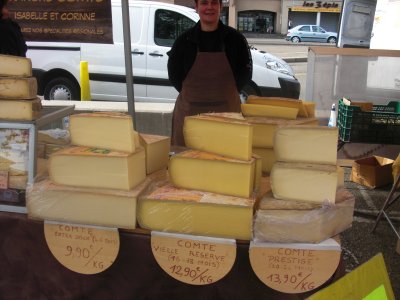
 Compare this stand, which clearly specializes in Comté and probably represents the makers (presumably Isabelle and Corinne)—for 9.90 euros/kg, you get "extra doux" (extra mild), aged 4-6 months; for 12.90 euros/kg, you get "vielle reserve" (old reserve), aged 16-18 months; the "prestige," aged 20-26 months, will set you back 13.90 euros/kg.
Compare this stand, which clearly specializes in Comté and probably represents the makers (presumably Isabelle and Corinne)—for 9.90 euros/kg, you get "extra doux" (extra mild), aged 4-6 months; for 12.90 euros/kg, you get "vielle reserve" (old reserve), aged 16-18 months; the "prestige," aged 20-26 months, will set you back 13.90 euros/kg.
At the right is part of the display of a "traiteur," a purveyor of prepared food, ready for reheating: back left, individual meat loaves, rolled in "crépinette" (pig's caul); front left, meatloaf-stuffed tomatoes; center, "gateau de foie de vollaile," individual muffin-shaped chicken-liver meatloaves, each sunk in an individual container of tomato sauce (after reheating, you turn them out sauce side up); right, quenelles de brochet (pike dumplings), in the classic "quenelle" shape, chilled after their initial poaching, about the size of lemons (on reheating in a sauce, they will puff up to twice or three times their size).
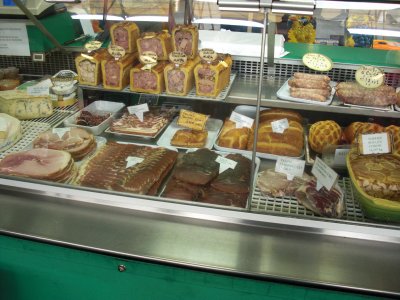
 Here are two displays of charcuterie (pork products other than fresh pork). Both feature, across the top, various sizes and shapes of "pâté en croûte" (meatloaf with or without liver baked in a pastry crust, to be eaten cold with mustard and pickles). After baking, the void left by shrinkage of the meat is filled with meat flavored aspic, poured in through a little hole in the top crust.
Here are two displays of charcuterie (pork products other than fresh pork). Both feature, across the top, various sizes and shapes of "pâté en croûte" (meatloaf with or without liver baked in a pastry crust, to be eaten cold with mustard and pickles). After baking, the void left by shrinkage of the meat is filled with meat flavored aspic, poured in through a little hole in the top crust.
Below those are various smoked pork products, raw and cooked ham, sausages, little individual sausages in brioche, and whatnot. One even had little disks of chevre wrapped in raw bacon, ready for grilling.
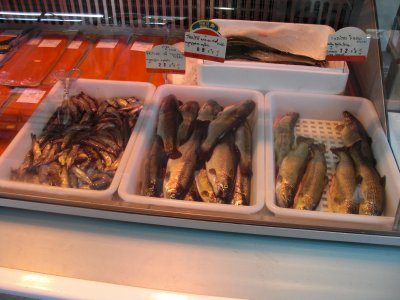
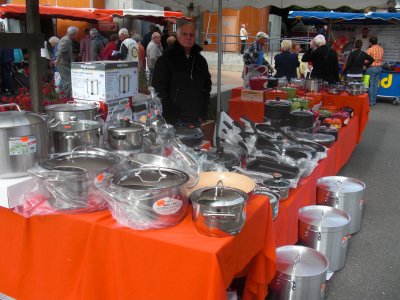
Here's the display of trout I think I mentioned in yesterday's entry. The ones in the front are rainbows, those in the back "farios"—both farmed locally and conscientiously labeled with their Latin names (Oncorhynchus mykis and Salmo truta fario, respectively). The tiny, "friture"-sized trout at the left are also rainbows. They've been individually gutted, but the heads are still on. They'll be dusted with flour and deep-fried whole, to be munched like french fries.
At the right is one of the two or three cookware stands. I especially admired the multicolored Le Creuset enameled cast iron at the far end.
In addition to all this stuff, I saw displays of baked goods (e.g., loaves of brioche lined up in size order from those intended for two people to those serving eight)); fresh pasta; honey; camomille and dried herbs in bulk; "coeur-de-boeuf" tomatoes (looking like our "ugly-ripe"), as well as many other varieties; peaches; apricots (some nearly as large as peaches, others the size of large strawberries); sweet cherries; big purple figs; many vegetable and bedding plants; melons; many kinds of dressed poultry, pork, and lamb (both raw and roasted); dressed rabbits, each with its liver neatly tucked into its rib-cage; green (and dark purple!) beans; snow peas; many kinds of potatotes; lots of large white Swiss chard; green and white asparagus; eggplant; peppers; fresh herbs; green onions; zucchini; pointed-head cabbage; strawberries, currants, and raspberries; tripe; sausages fresh and dried; carrots; and radishes. The poultry had its heads and feet still on so that you could be sure what you were getting, judge its age, etc. When you buy a bird, the vendor will clean it, trim it, and cut it up to your specifications.
As usual, one stand sold all kinds of olives. Another had glacéed fruit (strawberries, apples, papaya, mango, strawberries, melon, kiwi, kumquat, cranberries). Another had only "exotic" fruits: mangos, bananas, limes, passionfruit, pineapple, ginger, and sweet potatoes! One melon vendor was handing out samples, and the ground was littered for yards around with the little discarded slivers of rind. Another was calling his prices: "Melons! 3 for 2; 5 for 3!"

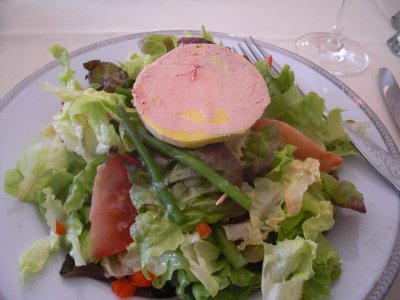 But, at last, I tore myself away and returned to find David finishing his breakfast, and we shortly set out for the 20-minute walk to Brou to look at the monastery. We actually toured part of it first, broke for lunch, and then went back, but I'll just stick the lunch photos in here, then go on describe Brou. We ate the Chalet de Brou, right next door to last night's restaurant. After an amuse-bouche of little fleurons of puff pastry, David had the plate of marinated raw salmon, and I had yet another salade gourmande. For dessert, I had coffee ice cream and cassis (black currant) sorbet while David had a coffee.
But, at last, I tore myself away and returned to find David finishing his breakfast, and we shortly set out for the 20-minute walk to Brou to look at the monastery. We actually toured part of it first, broke for lunch, and then went back, but I'll just stick the lunch photos in here, then go on describe Brou. We ate the Chalet de Brou, right next door to last night's restaurant. After an amuse-bouche of little fleurons of puff pastry, David had the plate of marinated raw salmon, and I had yet another salade gourmande. For dessert, I had coffee ice cream and cassis (black currant) sorbet while David had a coffee.
Now, Brou. It's a tale of two Marguerites. In 1480, Marguerite de Bourbon vowed that, if her husband (Philip, count of Bresse) recovered from a hunting accident, she would convert the old priory of Brou into a monastery. He recovered, but Marguerite died before she could fulfill the vow.
Some years earlier, Marie de Bourgogne, only daughter of Charles le Téméraire, last of the great dukes of Burgundy (remember him from my 2008 diary? Charles the Pushy, who tried to annex Nancy and got his comeuppance at the hands of the young Renée d'Anjou?) married Maximilien de Habsbourg, who became Holy Roman Emperor in 1508. They had two children, Philippe le Beau, who succeeded him as emperor, and Marguerite d'Austriche, who was born in Brussels in 1480, just as Marguerite de Bourbon was making her vow. Marie died when little Marguerite d'Autriche, the real heroine of our story, was just two years old. About the same time, as part of complicated treaty negotiations, Marguerite was married (at age 2) to Charles, the son of Louis XI of France, and sent off to join his family. She was raised at Amboise (one of the best castles of the Loire valley) and received an excellent education under the supervision of Anne de Beaujeu (Charles's older sister). When Louis died nine years later, Marguerite was therefore (at age 11) queen of France, but her husband, then Charles VIII, repudiated her to marry Anne de Bretagne (an important step in his conquest of Brittany).
In 1497, at age 17, Marguerite married (for love, according to reports at the time) Juan de Castille, crown prince of Spain. Her brother Philippe le Beau married Jeanne d'Aragone, the infanta. Unfortunately, it didn't last. Juan, always in fragile health, died a few months later.
In 1501, at age 21, she married Philibert le Beau (also 21), duc de Savoie (at the time, Savoie extended from Bourg-en-Bresse and Geneva to Nice and Turin) and son of Marguerite de Bourbon (she of the vow). Again, the marriage was apparently a very happy one, but three years later, Philibert caught cold while hunting and died.
So there was Marguerite d'Austriche, divorced once and widowed twice at age 24. At this point, concluding that all this could only be divine retribution, she decided to take up and fulfill her mother-in-law's vow of 26 years earlier to turn Brou into a monastery, and she resolved to do it right. She hired a great Flemish architect and all the best artists and artisans she could find, and she laid the first stone herself in 1506. That very fall, her older brother, Philippe le Beau (Holy Roman Emperor, remember) died, leaving a vast empire to be governed, a wife who had gone mad, and six children under the age of 7 (the oldest, under Marguerite's tutelage, grew up to be the amazing Charles Quint; read more about him in my 2010 travel diary). So Marguerite moved to Malines ("Mechelen" in Flemish; between Brussels and Antwerp) to raise the kids and run the empire, which she kept at peace through skillful diplomacy for 25 years before handing over to Charles. She closely supervised the construction of Brou from there but never saw it again—she died in 1530, two years before the church was consecrated.
Written 21 June 2011

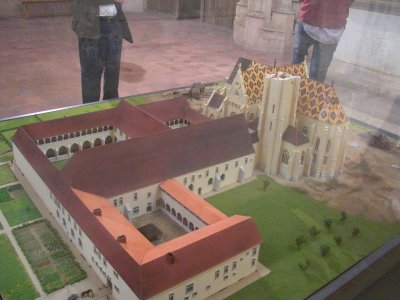 It was the age of the Flamboyant Gothic, in which Marguerite and the architect apparently believed strongly. Here's the facade of the church, from the front step of our restaurant of the night before.
It was the age of the Flamboyant Gothic, in which Marguerite and the architect apparently believed strongly. Here's the facade of the church, from the front step of our restaurant of the night before.
To the right, a model of the monastery (built first, before the church) and the partially completed church. David is facing the incomplete end that will become the facade in the photo.
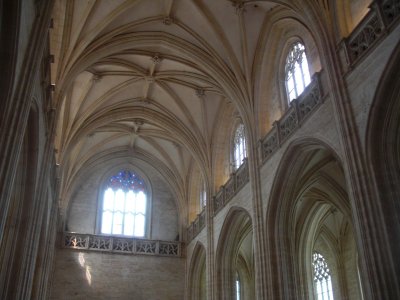
 You first enter through the nave, which, as you can see at the left, is rather bare for a gothic church.
You first enter through the nave, which, as you can see at the left, is rather bare for a gothic church.
At the inner end of the nave is the rood screen, shown at the right. At some point in the development of the Catholic church, rood screens (which separated the rabble of common people in the nave from the priests, monks, and dignitaries in the choir) were abolished, so very few remain in France, but both at that stage and during the revolution, Brou somehow escaped notice and suffered little damage or even change.
This rood screen had a dual purpose—besides the separation, it also carried, across its top, a walkway across which Marguerite could pass from her appartments (in the part of the monastery buildings nearest the street; she planned to retire there but did not live to do so) to her private chapel to the left of the choir, without crossing paths with the monks coming into the church from their quarters.
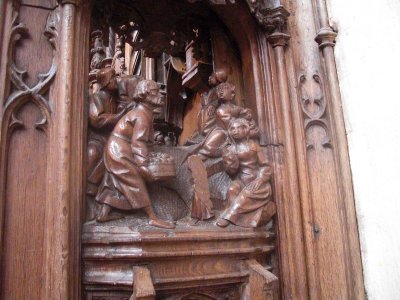
 Once you pass from the bare nave through the rood screen, all Flamboyant Gothic breaks loose. The 30-odd wooden choir stalls are elaborately carved (mostly walnut, I think). These are just a few samples.
Once you pass from the bare nave through the rood screen, all Flamboyant Gothic breaks loose. The 30-odd wooden choir stalls are elaborately carved (mostly walnut, I think). These are just a few samples.
Further forward still, between the choir and the apse, are the three tombs of Marguerite d'Autriche (on the left, next to her chapel), Philibert le Beau (her dead husband, in the place of honor in the center), and Marguerite de Bourgogne (her mother-in-law, who made the original vow, on the right).
Each tomb is double-decker. On the top, at head height, lies a splendid and flattering life-size effigy of the deceased in full sartorial splendor, as befits his or her rank. Below, at about knee height, lies another effigy portraying the deceased with all the warts and wrinkles and much more humbly attired—showing that death is the great leveler. Around the sides, like a sort of railing around the lower effigy, stand half-size saints carved in white marble.
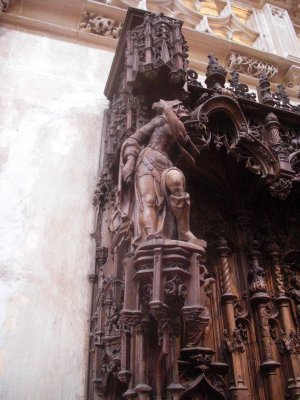
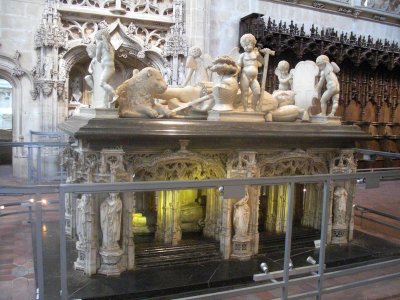 Here's a view of Philibert's tomb. A lion lies at his feet (his widow's feet rest on a greyhound, symbol of fidelity), and a cherub on the near side rests his hand on the deceased's plumed helmet. The elaborately carved archway in the background frames the niche where his mother's tomb lies. Some of the carved wooden choir stalls are visible at the back right.
Here's a view of Philibert's tomb. A lion lies at his feet (his widow's feet rest on a greyhound, symbol of fidelity), and a cherub on the near side rests his hand on the deceased's plumed helmet. The elaborately carved archway in the background frames the niche where his mother's tomb lies. Some of the carved wooden choir stalls are visible at the back right.
Carved everywhere—on stone ribbons around the tombs; on panels around the whole church; everywhere an inscription could go—was Marguerite d'Autriche's trademark slogan, "Fortune infortune fort une." It can be translated either "Fortune (i.e., fate) strongly disfavored one woman" or "Both good fortune and bad fortune strengthened one woman."
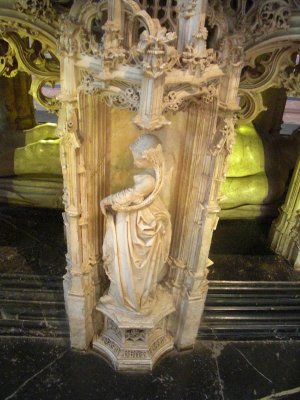
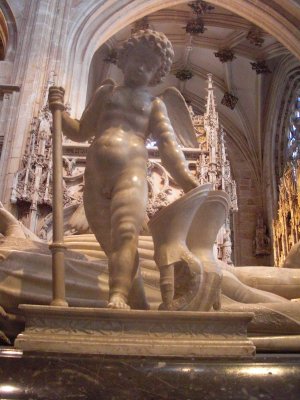 Here are the cherub on the other side of Philibert, looking after his armored gloves (and behind him the archway framing his widow's tomb), and one of the saints around the bottom.
Here are the cherub on the other side of Philibert, looking after his armored gloves (and behind him the archway framing his widow's tomb), and one of the saints around the bottom.
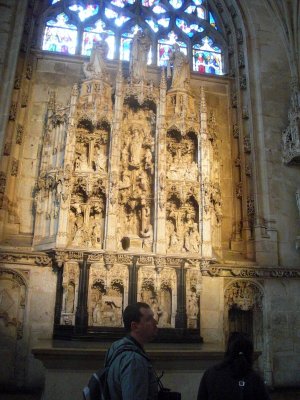 If anything, more elaborate and beautiful than the tombs is Marguerite's private chapel. Its altarpiece is this magnificant carved stone "seven pleasures (or joys? I forget) of the virgin."
If anything, more elaborate and beautiful than the tombs is Marguerite's private chapel. Its altarpiece is this magnificant carved stone "seven pleasures (or joys? I forget) of the virgin."
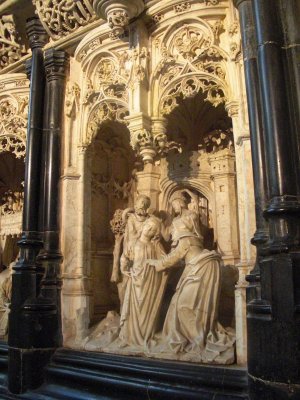 Here, at the right, is a closer view of one of the panels.
Here, at the right, is a closer view of one of the panels.
All the stained glass in the church is original—again, it miraculously escaped damage from all wars, revolutions, and upheavals since. It was all designed at Malines, under Marguerite's supervision, but then executed and installed at Brou.
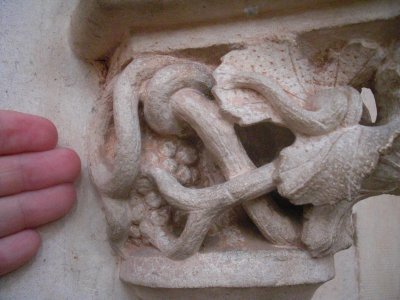 Here's a sample of the stone carving found throughout the choir, where it happened to be down low enough, with my fingers for scale.
Here's a sample of the stone carving found throughout the choir, where it happened to be down low enough, with my fingers for scale.
The floor didn't fare as well as the windows. It was entirely paved with colored faience tiles, which were just too fragile to stand up to 400+ years of foot traffic. A small fraction of it has been saved and relaid at the foot of the tombs, visible to visitors but protected by the tombs' guard rails.
In addition to the church, the cloisters and the monks' quarters are open for visitors. (The monks were dispersed at the time of the revolution, and the church has since been deconsecrated.) The area set aside for Marguerite and her suite was the wing nearest the street (i.e., nearest where David is standing by the model). The larger building in the middle housed the monks, and the others housed staff who handled the upkeep and whatever. The monks at Brou, unlike, say, Benedictines, who lived in common dormitories, had large private cells with antechambers, and their sole duty, day in and day out, was to pray for the salvation of the souls of Philibert and the two Marguerites.
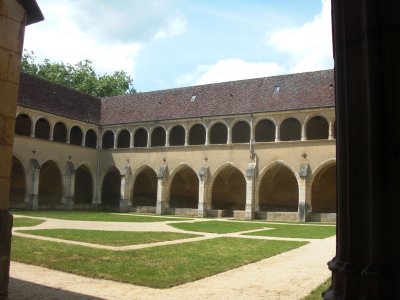
 The cloisters are unique in being double-decker (like the tombs, although I'm not sure any connection was intended. In one of the courtyards is a well that served as the monastery's water supply. It's now disused and lined with a lovely growth of hartstongue ferns. The cloister roof in that courtyard is divided between a section that has been recently repaired (i.e., you can see the shiny new tiles among the older weathered ones) and one in imminent need of repair (i.e., tiles are visibly slipping from their positions, and a temporary barrier at the eaves protects passers-by from any that fall.
The cloisters are unique in being double-decker (like the tombs, although I'm not sure any connection was intended. In one of the courtyards is a well that served as the monastery's water supply. It's now disused and lined with a lovely growth of hartstongue ferns. The cloister roof in that courtyard is divided between a section that has been recently repaired (i.e., you can see the shiny new tiles among the older weathered ones) and one in imminent need of repair (i.e., tiles are visibly slipping from their positions, and a temporary barrier at the eaves protects passers-by from any that fall.
At the right is an image from the establishment's impeccable stainless-steel restrooms. Note that the sink doesn't have any "sink"—it's just a stainless-steel grid.

 The monks' quarters are now a museum of Bourg-en-Bresse-related art (yes, lots of paintings of chickens, but also other stuff, e.g., by people from the area). My favorite piece was this model (plaster, about two feet high) for Unknown Political Prisoner by Louis Leygue (1905-1992, born in Bourg). The final was probably stone; I don't know how big.
The monks' quarters are now a museum of Bourg-en-Bresse-related art (yes, lots of paintings of chickens, but also other stuff, e.g., by people from the area). My favorite piece was this model (plaster, about two feet high) for Unknown Political Prisoner by Louis Leygue (1905-1992, born in Bourg). The final was probably stone; I don't know how big.
I think what astonished me the most was learning, near the end, that this entire establishment, 28 years in the building, at untold expense and large enough for a cast of hundreds, was intended to house just 12 monks and their support personnel—perhaps 30 people in all.
When we finished at the monastery, I wanted to stop on the way back to visit the famous historical pharmacy in the nearby "Hôtel Dieu" (i.e., church-run charity hospital, somewhat later in date than the monastery, now, like the one in Beane, a retirement home), where hundreds of glass and porcelain jars still line the shelves, some of them with their original herbal contents, and various historical equipment is on display. But David's feet were tired, so he headed back to the hotel, while I peeled off at the Hôtel Dieu. It took me only a few minutes to ascertain that it is open only for guided tours and only on alternate Saturdays if the phase of the moon is right. I had missed the last tour of the current cycle while we toured the monastery. Ah, well—I took the opportunity to walk back to the hotel by a different route, just to look around.
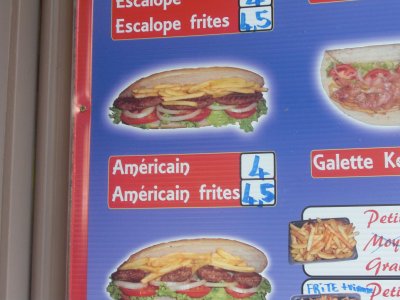
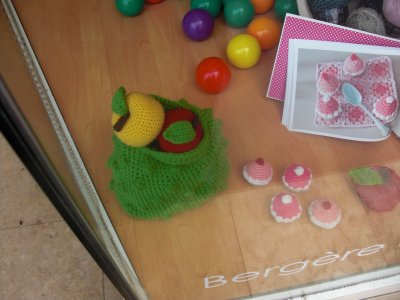 Among 0the interesting things I spotted were the spherical concrete fountain shown above; this photo outside a kebab shop of what the French call an "americain" (i.e., an American), consisting of a short, wide baguette split and filled with three burger patties, lettuce, tomato, onion, and a layer of french fries; a narrow storefront that had been converted, clearly by hand, into a sort of vending machine promising "home made pizza in four minutes" through a wide slot in the middle (as opposed, I guess, to the factory-made pizza dispensed by the much more professional-looking kiosk described in last year's blog, near the Brussels airport; and, in a yard-shop window, these great crocheted fruits and cupcakes.
Among 0the interesting things I spotted were the spherical concrete fountain shown above; this photo outside a kebab shop of what the French call an "americain" (i.e., an American), consisting of a short, wide baguette split and filled with three burger patties, lettuce, tomato, onion, and a layer of french fries; a narrow storefront that had been converted, clearly by hand, into a sort of vending machine promising "home made pizza in four minutes" through a wide slot in the middle (as opposed, I guess, to the factory-made pizza dispensed by the much more professional-looking kiosk described in last year's blog, near the Brussels airport; and, in a yard-shop window, these great crocheted fruits and cupcakes.
Dinner was at Place Bernard, the restaurant in our hotel, named for the square in front of the building. It's another in the George Blanc group of restaurants, our only one, as it turned out, since the St. Laurent in Mâcon was full. I was disappointed at the time, but I've since checked the websites of the two restaurants and discovered they have the same menu! Not that that's necessarily bad—we could certainly have chosen two different dinners from the choices available, but it lessens the disappointment to know that we didn't miss anything.
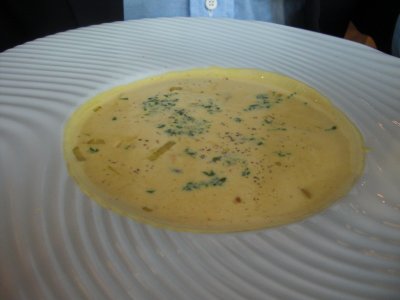
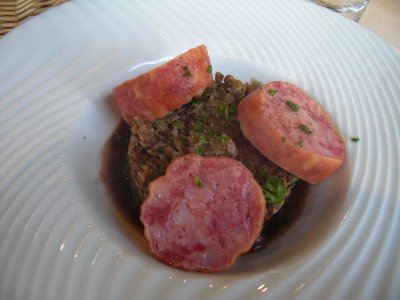 First course, David: Mollusc soup with cream, leeks, and turmeric. Excellent. I'm going to have to try that at home. [Note added later: Cooked 1 leek, finely sliced, slowly in a little oil in a covered pot with a spoonful of turmeric. Added an 8-oz bottle of clam juice, the juice from an 8-oz can of mussels, and some cream and simmered until the leeks were very tender. Thickened slightly by stirring in a little cornstarch suspended in cold water. Added the mussels and served. Excellent.]
First course, David: Mollusc soup with cream, leeks, and turmeric. Excellent. I'm going to have to try that at home. [Note added later: Cooked 1 leek, finely sliced, slowly in a little oil in a covered pot with a spoonful of turmeric. Added an 8-oz bottle of clam juice, the juice from an 8-oz can of mussels, and some cream and simmered until the leeks were very tender. Thickened slightly by stirring in a little cornstarch suspended in cold water. Added the mussels and served. Excellent.]
First course, me: Stuffed pigs' feet with Lyonnaise lentil salad. Wow! This was among the best dishes of the trip! As you can see from the photo, it looked pretty much like a sausage—David was expecting, and I was prepared for, something a little more, um, anatomical. Pigs' feet had been cooked, deboned, chopped, and stuffed back into the cylindrical skin of the foot. Either before or after cooking, they had been salted and/or cured, to a ham-like flavor, but the finished product was incredibly rich and succulent. The lentil salad was a little less oily and vinegary than the version Julia Child makes but excellent nonetheless and a perfect foil for the pig's feet. I'll look into it, but I'm not optimistic about being able to duplicate that at home.

 Main course, David: Chops of milk-fed lamb with "lasagnes of eggplant and sweet pepper." As you can see, the "lasagnes" of the description must be the lasagne noodles, as the dish took the form of alternating flat sheets of eggplant and pepper.
Main course, David: Chops of milk-fed lamb with "lasagnes of eggplant and sweet pepper." As you can see, the "lasagnes" of the description must be the lasagne noodles, as the dish took the form of alternating flat sheets of eggplant and pepper.
Main course, me: Braised veal cheeks, "meurette style" with "melting carrots." Another winner. Succulent veal cheeks braised to fork tenderness in a dark, rich red-wine sauce, then showered with lardons, crisp croutons, and meltingly tender carrots. Like pot roast, only more so. Scrumptious.
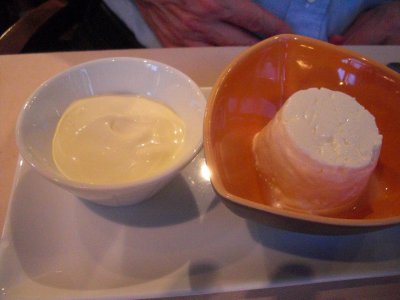
 Cheese, David: The now routine fromage blanc, this time with the cream on the side.
Cheese, David: The now routine fromage blanc, this time with the cream on the side.
Cheese, me: Another half Saint Marcellin, this one much less proteolysed than is typical around here, but still a good complement to the couple of walnuts and tuft of salad that came with it.
Another frequent option I've seen on menus in this area is "café gourmand"—gourmet coffee. It's offered as a dessert option and consists of coffee and an assortment of about three small desserts. David went with that option.
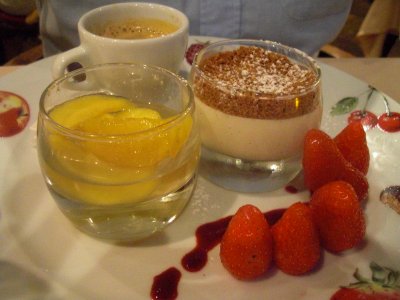
 Dessert, David: Coffee, accompanied by a panna cotta topped with a thick layer of gingerbread crumbs, fresh strawberries with a drizzle of red fruit coulis, and a glass of fruit in syrup. We couldn't actually tell what kind of fruit it was—it could have been soft apple, firm pear, or even firm peach. Pretty good, though.
Dessert, David: Coffee, accompanied by a panna cotta topped with a thick layer of gingerbread crumbs, fresh strawberries with a drizzle of red fruit coulis, and a glass of fruit in syrup. We couldn't actually tell what kind of fruit it was—it could have been soft apple, firm pear, or even firm peach. Pretty good, though.
Dessert, me: Strawberries again, this time with vanilla ice cream.
previous entry
List of Entries
next entry

 Definitely another of those shutter-happy days (and remember, of course, that every single day I took at least 20 photos for every one I have room for here). The ladies at the Office de Tourisme had mentioned that Saturday was market day, just around the corner from our hotel, so I left David a note, scarfed my breakfast, and headed out.
Definitely another of those shutter-happy days (and remember, of course, that every single day I took at least 20 photos for every one I have room for here). The ladies at the Office de Tourisme had mentioned that Saturday was market day, just around the corner from our hotel, so I left David a note, scarfed my breakfast, and headed out.
 These squash blossoms, for stuffing and either poaching or frying, are the less expensive male ones—all you get is the blossom. Below them are large leaves of white Swiss chard. In the background, behind the scale, you can just see a dish of the female flowers, with their tiny zucchinis attached.
These squash blossoms, for stuffing and either poaching or frying, are the less expensive male ones—all you get is the blossom. Below them are large leaves of white Swiss chard. In the background, behind the scale, you can just see a dish of the female flowers, with their tiny zucchinis attached.
 Here are parts of a cheese display; each photo covers perhaps 1/4 of the assortment on offer. At the left are mostly goat cheeses (note the gray truncated pyramids of Valençay); at the right mostly cow (the white spheres are Gaperon, a cheese strongly flavored with garlic and pepper; to their left is Fourme d'Ambert, a local blue).
Here are parts of a cheese display; each photo covers perhaps 1/4 of the assortment on offer. At the left are mostly goat cheeses (note the gray truncated pyramids of Valençay); at the right mostly cow (the white spheres are Gaperon, a cheese strongly flavored with garlic and pepper; to their left is Fourme d'Ambert, a local blue).
 Compare this stand, which clearly specializes in Comté and probably represents the makers (presumably Isabelle and Corinne)—for 9.90 euros/kg, you get "extra doux" (extra mild), aged 4-6 months; for 12.90 euros/kg, you get "vielle reserve" (old reserve), aged 16-18 months; the "prestige," aged 20-26 months, will set you back 13.90 euros/kg.
Compare this stand, which clearly specializes in Comté and probably represents the makers (presumably Isabelle and Corinne)—for 9.90 euros/kg, you get "extra doux" (extra mild), aged 4-6 months; for 12.90 euros/kg, you get "vielle reserve" (old reserve), aged 16-18 months; the "prestige," aged 20-26 months, will set you back 13.90 euros/kg.
 Here are two displays of charcuterie (pork products other than fresh pork). Both feature, across the top, various sizes and shapes of "pâté en croûte" (meatloaf with or without liver baked in a pastry crust, to be eaten cold with mustard and pickles). After baking, the void left by shrinkage of the meat is filled with meat flavored aspic, poured in through a little hole in the top crust.
Here are two displays of charcuterie (pork products other than fresh pork). Both feature, across the top, various sizes and shapes of "pâté en croûte" (meatloaf with or without liver baked in a pastry crust, to be eaten cold with mustard and pickles). After baking, the void left by shrinkage of the meat is filled with meat flavored aspic, poured in through a little hole in the top crust.


 But, at last, I tore myself away and returned to find David finishing his breakfast, and we shortly set out for the 20-minute walk to Brou to look at the monastery. We actually toured part of it first, broke for lunch, and then went back, but I'll just stick the lunch photos in here, then go on describe Brou. We ate the Chalet de Brou, right next door to last night's restaurant. After an amuse-bouche of little fleurons of puff pastry, David had the plate of marinated raw salmon, and I had yet another salade gourmande. For dessert, I had coffee ice cream and cassis (black currant) sorbet while David had a coffee.
But, at last, I tore myself away and returned to find David finishing his breakfast, and we shortly set out for the 20-minute walk to Brou to look at the monastery. We actually toured part of it first, broke for lunch, and then went back, but I'll just stick the lunch photos in here, then go on describe Brou. We ate the Chalet de Brou, right next door to last night's restaurant. After an amuse-bouche of little fleurons of puff pastry, David had the plate of marinated raw salmon, and I had yet another salade gourmande. For dessert, I had coffee ice cream and cassis (black currant) sorbet while David had a coffee.
 It was the age of the Flamboyant Gothic, in which Marguerite and the architect apparently believed strongly. Here's the facade of the church, from the front step of our restaurant of the night before.
It was the age of the Flamboyant Gothic, in which Marguerite and the architect apparently believed strongly. Here's the facade of the church, from the front step of our restaurant of the night before.
 You first enter through the nave, which, as you can see at the left, is rather bare for a gothic church.
You first enter through the nave, which, as you can see at the left, is rather bare for a gothic church.
 Once you pass from the bare nave through the rood screen, all Flamboyant Gothic breaks loose. The 30-odd wooden choir stalls are elaborately carved (mostly walnut, I think). These are just a few samples.
Once you pass from the bare nave through the rood screen, all Flamboyant Gothic breaks loose. The 30-odd wooden choir stalls are elaborately carved (mostly walnut, I think). These are just a few samples. 
 Here's a view of Philibert's tomb. A lion lies at his feet (his widow's feet rest on a greyhound, symbol of fidelity), and a cherub on the near side rests his hand on the deceased's plumed helmet. The elaborately carved archway in the background frames the niche where his mother's tomb lies. Some of the carved wooden choir stalls are visible at the back right.
Here's a view of Philibert's tomb. A lion lies at his feet (his widow's feet rest on a greyhound, symbol of fidelity), and a cherub on the near side rests his hand on the deceased's plumed helmet. The elaborately carved archway in the background frames the niche where his mother's tomb lies. Some of the carved wooden choir stalls are visible at the back right.
 Here are the cherub on the other side of Philibert, looking after his armored gloves (and behind him the archway framing his widow's tomb), and one of the saints around the bottom.
Here are the cherub on the other side of Philibert, looking after his armored gloves (and behind him the archway framing his widow's tomb), and one of the saints around the bottom. If anything, more elaborate and beautiful than the tombs is Marguerite's private chapel. Its altarpiece is this magnificant carved stone "seven pleasures (or joys? I forget) of the virgin."
If anything, more elaborate and beautiful than the tombs is Marguerite's private chapel. Its altarpiece is this magnificant carved stone "seven pleasures (or joys? I forget) of the virgin." Here, at the right, is a closer view of one of the panels.
Here, at the right, is a closer view of one of the panels. Here's a sample of the stone carving found throughout the choir, where it happened to be down low enough, with my fingers for scale.
Here's a sample of the stone carving found throughout the choir, where it happened to be down low enough, with my fingers for scale.
 The cloisters are unique in being double-decker (like the tombs, although I'm not sure any connection was intended. In one of the courtyards is a well that served as the monastery's water supply. It's now disused and lined with a lovely growth of hartstongue ferns. The cloister roof in that courtyard is divided between a section that has been recently repaired (i.e., you can see the shiny new tiles among the older weathered ones) and one in imminent need of repair (i.e., tiles are visibly slipping from their positions, and a temporary barrier at the eaves protects passers-by from any that fall.
The cloisters are unique in being double-decker (like the tombs, although I'm not sure any connection was intended. In one of the courtyards is a well that served as the monastery's water supply. It's now disused and lined with a lovely growth of hartstongue ferns. The cloister roof in that courtyard is divided between a section that has been recently repaired (i.e., you can see the shiny new tiles among the older weathered ones) and one in imminent need of repair (i.e., tiles are visibly slipping from their positions, and a temporary barrier at the eaves protects passers-by from any that fall.
 The monks' quarters are now a museum of Bourg-en-Bresse-related art (yes, lots of paintings of chickens, but also other stuff, e.g., by people from the area). My favorite piece was this model (plaster, about two feet high) for Unknown Political Prisoner by Louis Leygue (1905-1992, born in Bourg). The final was probably stone; I don't know how big.
The monks' quarters are now a museum of Bourg-en-Bresse-related art (yes, lots of paintings of chickens, but also other stuff, e.g., by people from the area). My favorite piece was this model (plaster, about two feet high) for Unknown Political Prisoner by Louis Leygue (1905-1992, born in Bourg). The final was probably stone; I don't know how big. 
 Among 0the interesting things I spotted were the spherical concrete fountain shown above; this photo outside a kebab shop of what the French call an "americain" (i.e., an American), consisting of a short, wide baguette split and filled with three burger patties, lettuce, tomato, onion, and a layer of french fries; a narrow storefront that had been converted, clearly by hand, into a sort of vending machine promising "home made pizza in four minutes" through a wide slot in the middle (as opposed, I guess, to the factory-made pizza dispensed by the much more professional-looking kiosk described in last year's blog, near the Brussels airport; and, in a yard-shop window, these great crocheted fruits and cupcakes.
Among 0the interesting things I spotted were the spherical concrete fountain shown above; this photo outside a kebab shop of what the French call an "americain" (i.e., an American), consisting of a short, wide baguette split and filled with three burger patties, lettuce, tomato, onion, and a layer of french fries; a narrow storefront that had been converted, clearly by hand, into a sort of vending machine promising "home made pizza in four minutes" through a wide slot in the middle (as opposed, I guess, to the factory-made pizza dispensed by the much more professional-looking kiosk described in last year's blog, near the Brussels airport; and, in a yard-shop window, these great crocheted fruits and cupcakes.
 First course, David: Mollusc soup with cream, leeks, and turmeric. Excellent. I'm going to have to try that at home. [Note added later: Cooked 1 leek, finely sliced, slowly in a little oil in a covered pot with a spoonful of turmeric. Added an 8-oz bottle of clam juice, the juice from an 8-oz can of mussels, and some cream and simmered until the leeks were very tender. Thickened slightly by stirring in a little cornstarch suspended in cold water. Added the mussels and served. Excellent.]
First course, David: Mollusc soup with cream, leeks, and turmeric. Excellent. I'm going to have to try that at home. [Note added later: Cooked 1 leek, finely sliced, slowly in a little oil in a covered pot with a spoonful of turmeric. Added an 8-oz bottle of clam juice, the juice from an 8-oz can of mussels, and some cream and simmered until the leeks were very tender. Thickened slightly by stirring in a little cornstarch suspended in cold water. Added the mussels and served. Excellent.]
 Main course, David: Chops of milk-fed lamb with "lasagnes of eggplant and sweet pepper." As you can see, the "lasagnes" of the description must be the lasagne noodles, as the dish took the form of alternating flat sheets of eggplant and pepper.
Main course, David: Chops of milk-fed lamb with "lasagnes of eggplant and sweet pepper." As you can see, the "lasagnes" of the description must be the lasagne noodles, as the dish took the form of alternating flat sheets of eggplant and pepper.
 Cheese, David: The now routine fromage blanc, this time with the cream on the side.
Cheese, David: The now routine fromage blanc, this time with the cream on the side.
 Dessert, David: Coffee, accompanied by a panna cotta topped with a thick layer of gingerbread crumbs, fresh strawberries with a drizzle of red fruit coulis, and a glass of fruit in syrup. We couldn't actually tell what kind of fruit it was—it could have been soft apple, firm pear, or even firm peach. Pretty good, though.
Dessert, David: Coffee, accompanied by a panna cotta topped with a thick layer of gingerbread crumbs, fresh strawberries with a drizzle of red fruit coulis, and a glass of fruit in syrup. We couldn't actually tell what kind of fruit it was—it could have been soft apple, firm pear, or even firm peach. Pretty good, though.